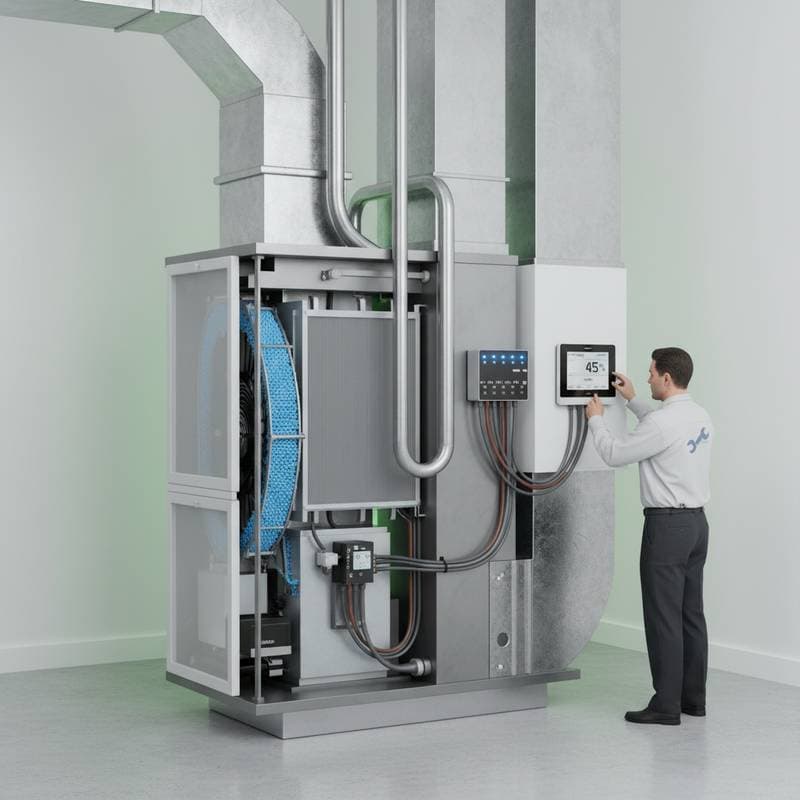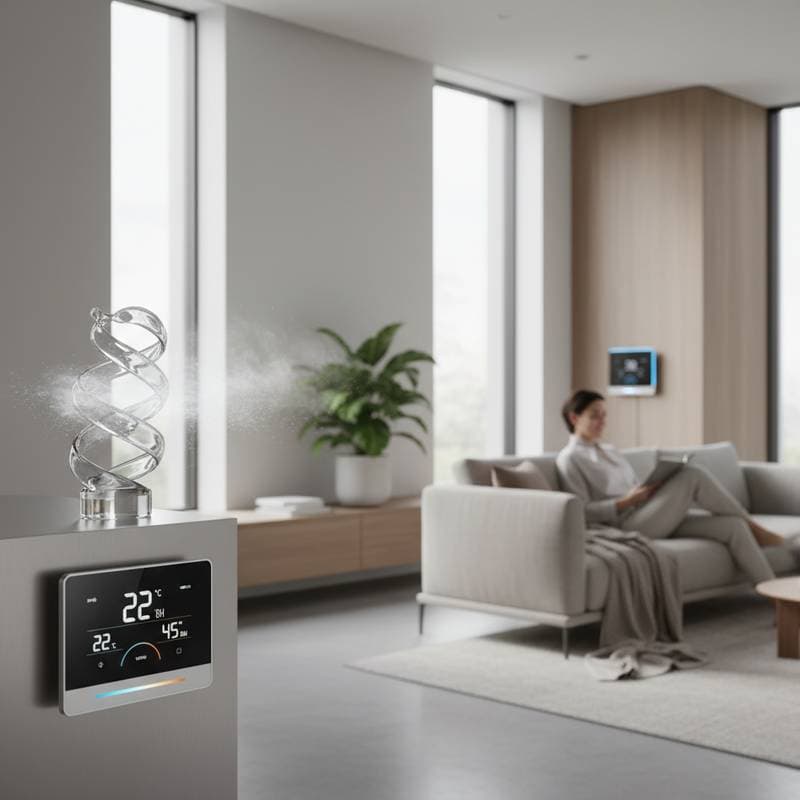HVAC-integrated humidity control upgrade: $2,000 to $6,000
Smart humidity sensor installation: $150 to $500
National Average Cost Statistics
| Metric | Amount |
|---|---|
| National average cost | $6,500 |
| Minimum cost | $150 |
| Maximum cost | $12,000 |
| Average cost range | $2,000 to $8,000 |
Cost data derives from research and project costs reported by members.
Detailed Cost Breakdowns
Whole-Home Dehumidifiers
Whole-home dehumidifiers integrate directly with HVAC ductwork to extract excess moisture from the air prior to circulation throughout the residence.
| System Capacity | Average Cost (Installed) |
|---|---|
| Up to 2,000 sq. ft. | $3,000 to $5,000 |
| 2,000 to 3,500 sq. ft. | $5,000 to $8,000 |
| 3,500+ sq. ft. | $8,000 to $12,000 |
Larger-capacity units incur higher expenses but manage expansive areas with efficiency. These systems frequently pair with smart thermostats to enable enhanced control over moisture levels.
HVAC-Integrated Upgrades
For homes equipped with central HVAC systems, incorporating humidity control proves a cost-effective enhancement.
| Upgrade Type | Average Cost |
|---|---|
| Humidistat installation | $250 to $600 |
| Smart thermostat with humidity control | $300 to $800 |
| Dehumidification module retrofit | $1,500 to $4,000 |
Such modifications empower existing setups to regulate humidity levels automatically, ensuring consistent indoor conditions.
Labor Versus Equipment Costs
| Component | Percentage of Total Cost |
|---|---|
| Equipment | 60% |
| Labor | 30% |
| Testing and commissioning | 10% |
Labor expenses fluctuate based on factors such as duct accessibility, electrical modifications, and wiring for control systems, particularly with smart sensor integrations.
Related Expenses to Consider
Humidity control installations may involve supplementary costs that warrant planning.
| Related Expense | Average Cost |
|---|---|
| Duct cleaning before installation | $300 to $700 |
| Condensate pump or drain line | $150 to $400 |
| Electrical upgrades or new outlet | $200 to $500 |
| Mold inspection prior to install | $250 to $600 |
| Annual maintenance contract | $200 to $400 |
Many homeowners opt for complementary air purifiers or UV light systems to further address airborne spores alongside humidity management.
Deciding Between Repair and Replacement
When an HVAC system fails to regulate humidity adequately or exhibits mold within ducts, evaluation becomes essential. Addressing minor concerns, such as obstructed coils or malfunctioning sensors, ranges from $150 to $600. However, substituting obsolete parts can surpass $4,000.
Opt for replacement under these conditions:
- Equipment exceeds ten years in age.
- Frequent condensation or musty smells occur.
- Energy expenses rise despite routine upkeep.
- Humidity levels remain above fifty percent.
Contemporary systems feature variable-speed compressors and intelligent sensors that modulate airflow dynamically. These advancements deliver heightened comfort and sustained energy savings.
Strategies to Reduce Costs on Humidity Control Systems
Homeowners can minimize expenditures through strategic planning and informed purchasing.
- Obtain multiple quotes from certified HVAC professionals to evaluate options.
- Time installations for off-peak periods to benefit from reduced demand.
- Seek rebates or incentives offered by utility providers for efficient models.
- Combine services like duct cleaning and thermostat enhancements for bundled savings.
- Select capacity matched precisely to home size to prevent unnecessary overinvestment in larger units.
- Implement regular maintenance to avert expensive failures or moisture-induced harm.
- Incorporate smart thermostats to optimize energy consumption and automate humidity adjustments.
- Address air leaks in windows, doors, and ducts to lessen the system's humidity burden.
Adopting these practices renders humidity control more economical while fortifying mold prevention efforts.
Frequently Asked Questions on HVAC Humidity Technology
How Much Does a Whole-Home Dehumidifier Cost?
Whole-home dehumidifiers typically range from $4,000 to $12,000, influenced by capacity, features, and installation demands.
What Humidity Level Prevents Mold Growth?
Mold growth becomes unlikely when indoor humidity remains below fifty percent. Optimal ranges for comfort and health span thirty to fifty percent.
Can Humidity Control Be Added to an Existing HVAC System?
Yes, compatible upgrades such as humidistats, dehumidifiers, or smart thermostats can integrate for $2,000 to $6,000.
Do Smart Thermostats Monitor Humidity?
Numerous advanced smart thermostats incorporate humidity sensors that fine-tune HVAC functions to sustain equilibrium.
How Long Does Installation Take?
Whole-home systems generally require one to two days, whereas minor additions like sensors or thermostats complete in several hours.
What Maintenance Do Dehumidifiers Need?
Routine tasks include coil and drain line cleaning, filter replacements, and yearly professional inspections for reliable operation.
Can Humidity Control Reduce Energy Bills?
Yes, proper humidity balance enhances perceived coolness at elevated temperatures, thereby decreasing reliance on air conditioning.
Should One Choose a Portable or Whole-Home Unit?
Portable options suit individual rooms affordably, yet whole-home solutions provide uniform control throughout the property.
What Signs Indicate Humidity Issues in a Home?
Evidence includes window condensation, persistent musty odors, and apparent mold on walls or ceilings.
Steps to Achieve Mold-Free Indoor Air
Implementing effective humidity control through HVAC upgrades transforms living spaces into healthier environments. Homeowners gain not only mold resistance but also improved energy efficiency and overall well-being. Consult a qualified professional to assess needs and initiate protective measures today.



